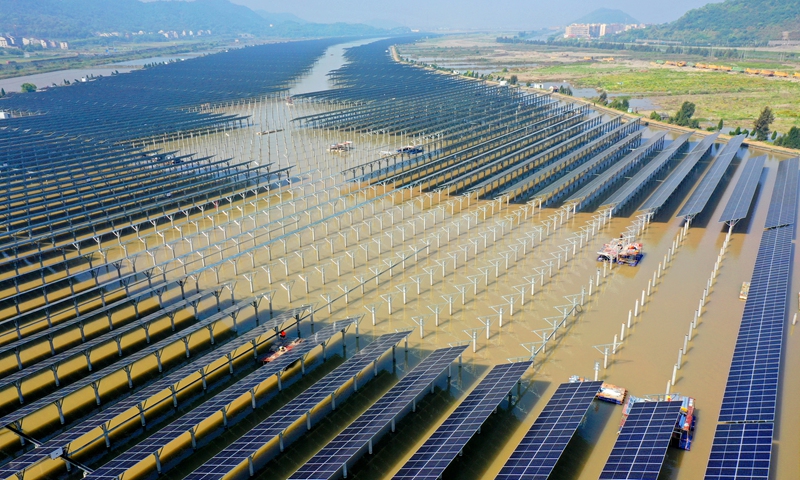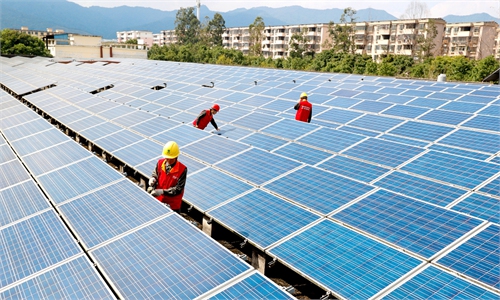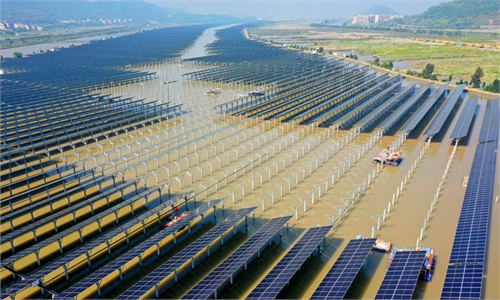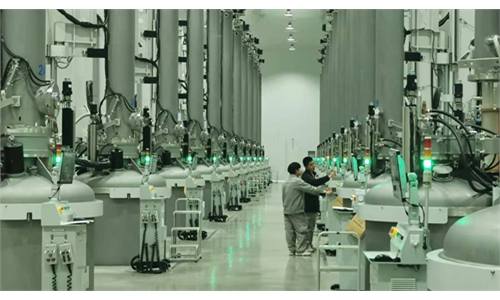Chinese FM calls US 'epicenter' of forced labor after claims against Xinjiang's PV sector

Workers install the final solar panels at the Jiangxia Tidal Power Station in Wenling, East China's Zhejiang Province, on April 21, 2022. The station is China's first power plant to use tidal and solar power simultaneously, and the fourth in the world. The 2,000-mu (133 hectares) project will have an installed capacity of 100 megawatts. Photo: VCG
China's Foreign Ministry on Wednesday refuted US claims about the photovoltaic (PV) sector in Northwest China's Xinjiang Uygur Autonomous Region involving so-called forced labor, stressing that such fabricated claims can't smear the local PV industry, whereas the US is the "epicenter" of forced labor.
Dark clouds can never block the sun, and the fact that the US deliberately fabricated lies about "forced labor" in Xinjiang will disrupt the global PV sector's trade and supply chain, and undermine global efforts to tackle climate change, and also harm the US itself, Chinese Foreign Ministry spokesperson Zhao Lijian said on Wednesday at a press briefing.
Zhao's remarks came after US Trade Representative Katherine Tai stated that the US relies on China for 85 percent of its solar panels, and the whole industry chain runs across Xinjiang, which, she asserted, has a serious forced labor problem.
"China has repeatedly stressed that 'forced labor' in Xinjiang is an outright lie. The US attempts to exclude China from the global PV supply and industry chain by maliciously making up and spreading the lie through political manipulation, because China is the world's largest country in PV manufacturing and installed applications, and Xinjiang is the most significant global polysilicon production base," Zhao noted.
The US, however, should take a look at its own history and reality, as the epicenter of human trafficking and forced labor, said Zhao.
For instance, nearly 100,000 people are trafficked from outside the US for forced labor each year, and at least 500,000 people are currently enslaved in the country, Zhao noted. A large number of child laborers are still in the US working in agriculture, with many children working from the age of eight, according to Zhao.
The White House announced on Monday plans to suspend tariffs on solar panel imports from four Southeast Asian countries - Cambodia, Malaysia, Thailand and Vietnam - while excluding China, the major contributor to the global PV industry.
China's PV giant LONGi said earlier that the company was still assessing the impact, but the company does not rely on any single market and it has a full industry chain of PV production capacity in Malaysia and module capacity in Vietnam.
Despite the suppression by the US, China has been leading the world in the PV sector in multiple aspects.
In 2021, China's PV industry continued to soar. The production of PV modules ranked first in the world for the 15th consecutive year, and polysilicon production led the world for the 11th consecutive year, data from the China Photovoltaic Industry Association showed.
The output value of China's PV manufacturing in polysilicon, wafers, cells and modules exceeded 750 billion yuan ($112.07 billion) in 2021, while exports of silicon wafers, cells and modules exceeded $28 billion, a record high.
Global Times



